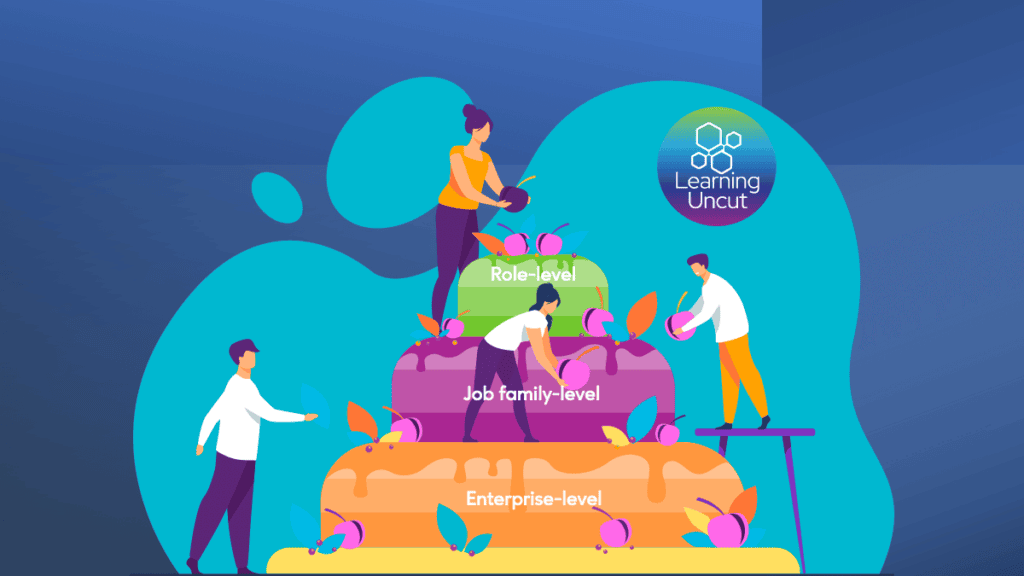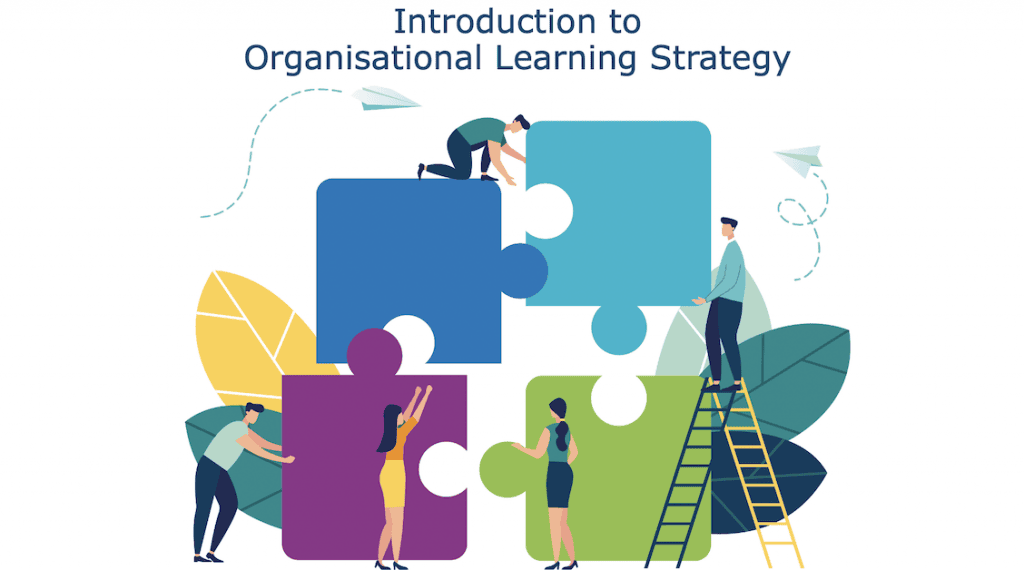Welcome back to our deep dive into solving the talent paradox! In this part, we focus on a critical aspect of skill building and management: selecting the correct level of Skills Framework for your organisation. This aspect of the talent landscape is crucial to our organisational DNA. If you’ve been with me through our discussions on the talent paradox, you’ll remember our deep dive into the skills crisis (read this blog first, if you haven’t: Navigating the Skills Crisis – Talent Paradox Part I). Building on that foundation, let’s spotlight the importance of the right framework approach in organisations.
Imagine skills frameworks as layers of a sumptuous cake – each layer with its flavour, each integral to the complete dessert experience. The enterprise level is our base layer, the job family or functional level is the middle, and the role-specific layer crowns the top. Let’s slice into these and explore them with the help of skills examples for a global tech company.
1. Enterprise-Level Critical Skills Framework:
The Broad View
At this highest level, the framework encompasses skills crucial for the entire organisation. It’s about identifying and prioritising skills that enhance the overall strategic objectives, culture, and operational efficiency of the company. This level ensures that all employees, regardless of their specific role, share a common set of skills and values that align with the organisation’s strategy.
Examples of enterprise-level critical skills for global tech company:
- Digital Literacy: In a tech company, it’s vital that all employees, whether in technical or non-technical roles, are comfortable with digital tools and platforms.
- Innovation and Creativity: This skill fosters a culture of continuous improvement and adaptation, essential in the fast-evolving tech sector.
- Data-Driven Decision Making: Encourages a culture where decisions are made based on data analysis, crucial for maintaining competitiveness and relevance.
- Agile Methodologies: Understanding agile methods allows teams to be more responsive and adaptable to change – a necessity in tech.
- Cross-Cultural Competence: For a global company, this skill ensures effective collaboration across different geographies and cultures.
Perks
- Unified Vision: A cohesive organisational culture.
- Strategic Alignment: Everything falls in line with the broader goals.
- Flexibility: Interpret and apply according to role nuances.
Hitches
- It can be too overarching to address specific role needs.
- What’s critical for one may not be for another.
- Tweaking a skill? A massive task!
2. Job Family-Level Skills Framework:
The Middle Ground
This level zooms in on specific categories or groups of jobs, focusing on skills relevant to those job families. It bridges the gap between the broad, organisational skills and the specific skill sets needed for individual roles. This framework helps to ensure that employees within the same job family are developing skills that are relevant to their specific area of work.
Let’s first consider examples of job families in a Global Tech Company:
Information Technology (IT) Operations, Product Management, Data Science and Analytics, Sales and Business Development, Software Development
The Software Development Job Family encompasses various roles focused on creating, testing, and maintaining software applications, ensuring they meet user needs and business objectives. Let’s explore examples of Job Family-Level Skills for the Software Development Job Family:
- Coding Proficiency: Essential for this job family to create and maintain the company’s software products.
- System Architecture Understanding: Enables design of efficient and scalable systems.
- Security Awareness: Particularly important in software development to protect against data breaches and other security threats.
- User Experience (UX) Design Principles: Ensures that the software is user-friendly and meets customer needs, a critical aspect of product development.
Perks
- Functional Alignment: Tailor-made for specific job families.
- Efficient Resource Allocation: No more spreading resources too thin.
- Easier Benchmarking: Position yourself effectively in the industry.
Hitches
- Some skills might overlap between job families.
- Rapid industry shifts might outdate the framework.
- Overemphasis might create departmental silos.
3. Role-Level Skills Framework:
The Finer Details
This is the icing on our cake! This is the most detailed level, focusing on individual job roles. It outlines the specific skills and expertise required for success in each unique role. This level helps employees, and their managers understand exactly what is needed to perform their jobs effectively and how they can grow and develop within their roles.
Let’s first consider examples of roles within the software development job family:
DevOps Engineer, Software Engineer, Front-End Developer, Back-End Developer, Full-Stack Developer, Software Architect
The Software Architect role involves designing the overall structure of software systems, setting technical standards, and ensuring alignment with business goals and user needs.
Let’s explore examples of Role-Level Skills for the Software Architect Role:
- System Design and Architecture Skills: Fundamental for creating the blueprint of software systems, ensuring they meet both technical and business requirements.
- Proficiency in Programming Languages: Essential for understanding the technical challenges and capabilities of the development team, often requiring knowledge in multiple languages like Java, Python, C#, etc.
- Experience with Database Management and Data Modeling: Important for ensuring the efficient and secure handling of data within software applications.
- Risk Management and Mitigation: Critical for identifying potential risks in the software development process and creating strategies to mitigate these risks.
- Strong Analytical and Problem-Solving Skills: Key for foreseeing potential issues in software designs and finding efficient solutions.
Perks
- High Specificity: Get right to the role’s core.
- Clear Expectations: Know exactly what’s needed for each role.
- Quick Adjustments: Swift updates for evolving roles.
Hitches
- It’s resource intensive.
- Skill overlap might lead to redundancy.
- The risk of making roles too niche.
Choosing the Right Level of Skills Framework
The first step in addressing the talent paradox is choosing a framework that aligns with your organisation’s size, industry, and specific challenges. Not all frameworks are created equal, and the choice you make can significantly influence the effectiveness of your skill building initiatives.
Selecting an appropriate framework is not just a procedural step; it’s a strategic decision. The right framework will ensure that the skills developed align with business goals, enhance the learning culture, and prepare the workforce for future challenges. Conversely, an ill-suited framework can lead to misaligned skills development, wasted resources, and a larger skills gap.
Factors to Consider
When selecting the appropriate Skills Framework Level for an organisation, it’s crucial to consider a range of factors to ensure it effectively aligns with its unique context and objectives. Additionally, understanding when to apply a combination approach is essential for addressing diverse needs. Here’s a consolidated view:
- Organisational Size and Complexity: Larger, more complex organisations might require more detailed frameworks, especially at the role level, to address the diverse needs of various departments and job functions.
- Industry Specifics: Different industries have unique skill requirements. A tech company, for instance, would focus more on digital skills, while a manufacturing firm might prioritise operational and technical skills.
- Strategic Objectives: The chosen framework should align with the long-term goals and strategic direction of the organisation. It’s crucial to ensure that the skills being developed support these objectives.
- Workforce Demographics: Consider the generational mix and diversity of the workforce. Different age groups and backgrounds might have varying learning needs and preferences.
- Technological Landscape: In fast-evolving industries, it’s important to choose a framework that not only addresses current technological needs but is also adaptable to future advancements.
- Learning Culture: The framework should complement the organisation’s learning culture, whether formal, informal, self-directed, or collaborative learning.
- Resource Availability: The selection should consider the resources (time, budget, personnel) available for implementing and sustaining the skill-building initiatives.
- Change Management Capability: The organisation’s ability to manage change effectively is crucial, especially if the framework requires significant shifts in learning and development approaches.
- Current Skills Gap: Understanding existing skill gaps helps choose a framework level that most effectively addresses these gaps.
- Future Skills Forecasting: Anticipating future skills needs is critical for staying ahead in the market and should be a factor in the framework selection.
By carefully considering these factors, an organisation can select a Skills Framework Level that is most appropriate and beneficial for its specific context and needs.
A combination of different framework levels may be necessary in certain situations:
- Diverse Business Units: Different departments may require distinct frameworks, especially in organisations with a wide range of business units.
- Rapid Growth or Scaling: A flexible approach helps address the evolving needs of a growing or scaling organisation.
- Mergers and Acquisitions: Combining frameworks can aid in integrating diverse workforces and cultures from different organisations.
- Global Operations with Local Differences: A global company might need an overarching enterprise-level framework while addressing local or regional specifics at the job family or role level.
- Balancing Short-term Needs with Long-term Goals: Addressing immediate skill gaps at a granular level while aligning with long-term strategic objectives through broader frameworks.
- Technological and Market Evolution: Ensuring current trends and future shifts are both addressed by leveraging different levels of frameworks.
- Employee Development Pathways: To support individual skill development and career progression, a blend of role-level and broader frameworks can be beneficial.
In summary, selecting the right Skills Framework Level requires a comprehensive analysis of organisational characteristics and needs, where a combination approach often offers the necessary flexibility and adaptiveness. This strategy ensures that the workforce is not only equipped to tackle current challenges but is also primed for future developments.
From aligning with organisational objectives to evaluating available resources, this journey demands deep introspection and a balance between simplicity and detail. While simplicity aids adoption, detail ensures specificity.
And remember, it’s not a one-size-fits-all. The key is adaptability. Assess, align, and iterate. By doing so, you address the talent paradox head-on, creating a skills ecosystem that is responsive to both current and future needs. The end game? A thriving organisation, agile in the face of change and rooted in a culture of continuous learning and development.
Until next time, stay committed to navigating and innovating through your talent strategies, and watch as your organisation transforms to meet the demands of an ever-evolving business landscape.


